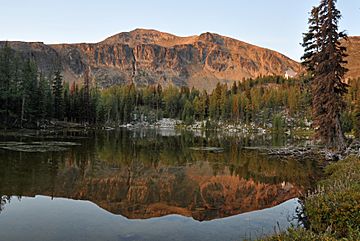Sheep Mountain (Okanogan County, Washington) facts for kids
Quick facts for kids Sheep Mountain |
|
|---|---|

Sheep Mountain reflected in Ramon Lakes at sunrise
|
|
| Highest point | |
| Elevation | 8,274 ft (2,522 m) |
| Prominence | 2,034 ft (620 m) |
| Listing | List of highest mountain peaks in Washington |
| Geography | |
| Location |
|
| Parent range | Okanogan Range North Cascades Cascade Range |
| Topo map | USGS Ashnola Mountain |
| Type of rock | Granodiorite, Gneiss |
| Climbing | |
| First ascent | 1925 Survey party |
| Easiest route | Hiking Southeast slopes |
Sheep Mountain is a tall mountain in Okanogan County, Washington. It stands about 8,274 feet (2,522 meters) high. This mountain is part of the Okanogan Range. This range is a smaller part of the larger North Cascades and Cascade Range mountains.
The mountain is located very close to the border between the United States and Canada. It sits inside the Pasayten Wilderness. This area is managed by the Okanogan National Forest. The Pacific Northwest Trail, a long hiking path, goes across the slopes of Sheep Mountain. Water from the mountain flows into Peeve Creek or into parts of the Ashnola River.
Sheep Mountain got its name because for 40 years, the grassy areas around it were used for sheep to graze in the summer. This was before the area became a protected wilderness.
Mountain Weather
Most of the weather in this area comes from the Pacific Ocean. It usually moves northeast towards the Cascade Mountains. When these weather systems reach the North Cascades, the tall mountains force the air upwards. This process is called orographic lift. As the air rises, it cools down and drops its moisture. This means a lot of rain or snow falls on the mountains.
Because of this, the western side of the North Cascades gets more rain and snow than the eastern side. This is especially true during the winter months. In winter, it's often cloudy. But in summer, high-pressure systems over the Pacific Ocean bring clear skies. This means there is often little or no cloud cover during the summer.
How the Mountains Formed
The North Cascades mountains have very rugged shapes. You can see sharp peaks, tall spires, long ridges, and deep valleys carved by glaciers. These different shapes and big changes in height happened because of geological events over millions of years. These events also caused the different weather patterns across the Cascade Range.
The Cascade Mountains started forming millions of years ago. This was during a time called the late Eocene Epoch. At that time, the North American Plate (a huge piece of Earth's crust) was slowly moving over the Pacific Plate. This movement caused a lot of volcanic activity, where molten rock came to the surface.
Also, small pieces of Earth's crust, called terranes, crashed into the North American continent. These pieces were made of oceanic and continental rock. These collisions helped build up the North Cascades about 50 million years ago.
Later, during the Pleistocene period, which was over two million years ago, huge sheets of ice called glaciers moved across the land. These glaciers advanced and then melted back many times. As they moved, they scraped away rock and left behind debris. This is why many river valleys in the area have a "U" shape. The combination of the land being pushed up (orogeny) and broken by faults, along with the glaciers, created the tall peaks and deep valleys we see in the North Cascades today.



